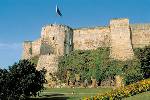Caen
The common work of William and Mathilda.
From the 1060's, William of Normandy built in Caen the largest fortress in Europe and this way conspicuously materialized his political and military power in the west of his dukedom, where the “Bastard's” legitimacy had been disputed by his own vassals.
|
Photo : Matthieu |
William and his wife Mathilda of Flander respectively founded the Men's Abbey and the Women's Abbey that had a spiritual influence all over Europe. The anecdote reports that the couple founded each a monastery so as to be forgiven their marriage between blood relations. The Pope was opposed to their union giving as a pretext a remote 5th-degree- cousinhood that linked to each other. This religious and politically correct pretext actually hid political and geostrategic ulterior motives. Both attached to the city of Caen, the couple chose to rest there eternally, each in the abbey church they had founded.
Caen has drawn a not inconsiderable part of its wealth thanks to the closeness to England, the conquest of which permitted the opening of new markets. The best example is the famous Caen limestone, of an exceptional quality, which passed in transit through the Caen port with the view to its exportation across the Channel.
The presence of these three founding monuments, and of a port and of a generous limestone deposit made the long-lasting development of this town possible and have served the Duke-King's ambitions : turn this little city into the 2nd capital of the dukedom after Rouen.
In spite of the allied bombardments in 1944 that daily harassed the town and its inhabitants, Caen still had its preserved historical monuments that had been respectfully integrated into the new urban network.


